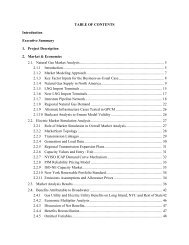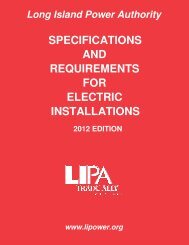Appendix E-2.c.i Energy Plan 2004-2013 Follow-up Studies and ...
Appendix E-2.c.i Energy Plan 2004-2013 Follow-up Studies and ...
Appendix E-2.c.i Energy Plan 2004-2013 Follow-up Studies and ...
You also want an ePaper? Increase the reach of your titles
YUMPU automatically turns print PDFs into web optimized ePapers that Google loves.
Re-powering Study for the Northport <strong>and</strong> Port Jefferson Power Stations<br />
<strong>Appendix</strong> II Northport System Descriptions<br />
• Condenser Vacuum Pumps [if applicable] (Cooling is provided to the liquid ring vacuum pump heat<br />
exchangers)<br />
• Feedwater Pump Lube Oil Cooler [if applicable]<br />
• Sample System Sample Coolers<br />
• Instrument/Service Air Compressors [if applicable]<br />
System components that could be subject to greater than their design pressures during operation are<br />
protected from over pressure during operation by pressure relief valves.<br />
Temperature control valves regulate cooling water flow through the turbine lube oil coolers <strong>and</strong> generator<br />
coolers.<br />
The flow of closed cooling water through the various components is either automatically regulated, or<br />
manually adjustable to meet each manufacturer’s recommendations.<br />
2.12 Instrument & Service Air<br />
Refer to PID 12-01A <strong>and</strong> 12-02A in <strong>Appendix</strong> III.<br />
At Northport, compressed air is s<strong>up</strong>plied throughout the facility <strong>and</strong> subdivided into instrument air <strong>and</strong><br />
service air according to the air quality requirements. The instrument air serves all users where dry oil-free<br />
air is required (i.e. air operated control valves, instrumentation), where there is a potential of freezing the<br />
service air line or if interr<strong>up</strong>tion of the air s<strong>up</strong>ply is not acceptable (i.e. atomizing air to the ammonia skid<br />
for the SCR system). The service air serves common users in the plant such as tools via hose connection<br />
stations located throughout the facility.<br />
The Instrument/Service Air System will have the following characteristics:<br />
Two (2) x 100% air compressors of the air-cooled (or water-cooled), lubricated, <strong>and</strong> rotary screw type.<br />
Each compressor is equipped with an inlet air filter silencer, air/oil separator vessel, air/water separator,<br />
aftercoolers, <strong>and</strong> controls.<br />
One (1) x 100% service air receiver is provided. The receiver provides surge capacity for the Service Air<br />
<strong>and</strong> Instrument Air Systems. It is constructed to ASME Code requirements <strong>and</strong> is designed for safe<br />
shutdown of the facility.<br />
The piping <strong>and</strong> control system will be arranged to prevent loss of pressure to the instrument air system on<br />
a service air system failure by a pressure control valve. The pressure control valve isolate the service air<br />
header on low instrument air pressure signal from the instrument air header <strong>and</strong> diverts air to the<br />
instrument air system.<br />
One, 100% d<strong>up</strong>lex air drying train for the instrument air system. The train consists of a prefilter, air<br />
dryers, <strong>and</strong> after filter stations. The prefilter removes the bulk liquid water <strong>and</strong> particles (5 microns or<br />
smaller). After the air passes through the dryer, the after filter removes any particles from the dryer<br />
desiccant (3 microns or smaller).<br />
The air dryer is of the dual tower heatless regenerative desiccant type. The system automatically controls<br />
the regeneration cycle of the dryers as required. Each air dryer tower is 100% unit capacity such that one<br />
tower can s<strong>up</strong>ply full unit dem<strong>and</strong> while the other is being regenerated. Each dryer <strong>and</strong> dryer tower will<br />
be equipped with remote operated isolation valves.<br />
March 30, 2009 165






